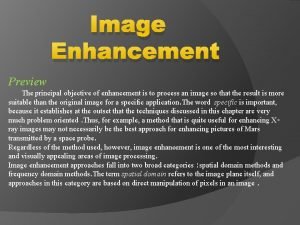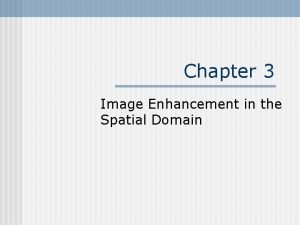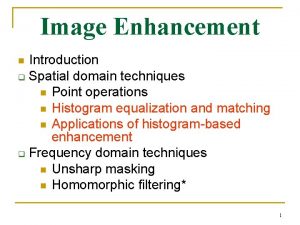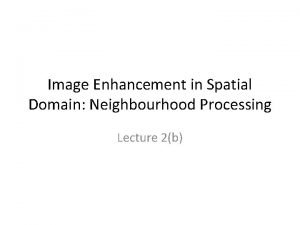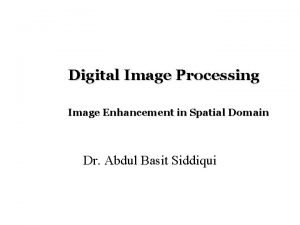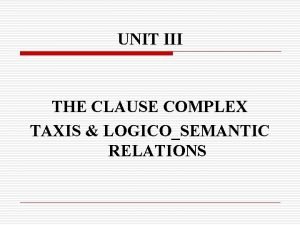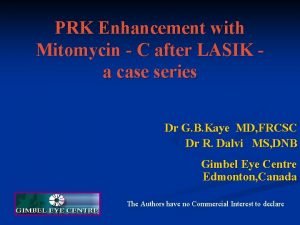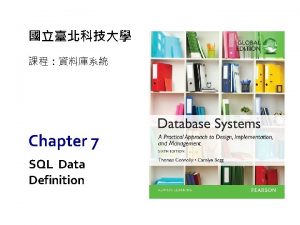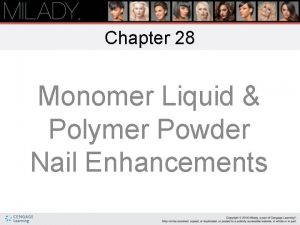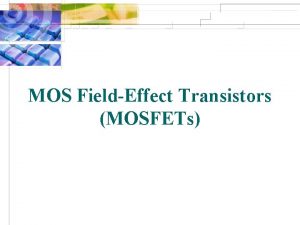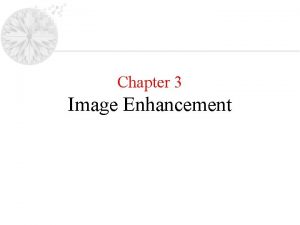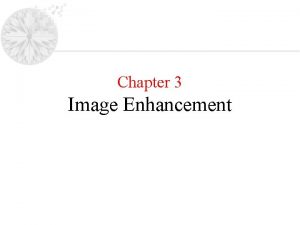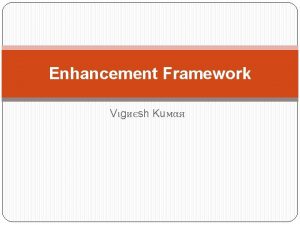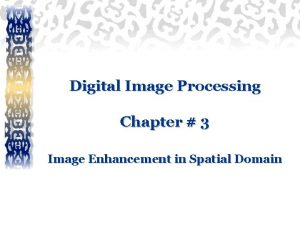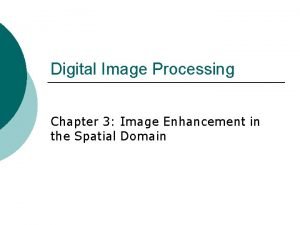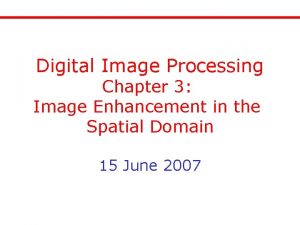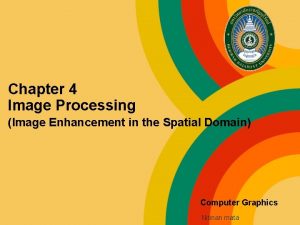Chapter 4 Image Enhancement What is image enhancement




















- Slides: 20

Chapter 4: Image Enhancement

• What is image enhancement? • Image enhancement is the process by which we improve an image so that it looks subjectively better. For example, whether more detail can be seen, or whether unwanted flickering has been removed, or the contrast is better. How can we enhance an image? • An image is enhanced when we • remove additive noise and interference; • remove multiplicative interference; • increase its contrast; • decrease its blurring. Some of the methods we use to achieve the above are • • smoothing and low pass filtering; • • sharpening or high pass filtering; • • histogram manipulation and • • generic deblurring algorithms, or algorithms that remove noise while avoid blurring the image.

What are the types of noise present in an image? • Noise in images is often assumed to be either impulse noise or Gaussian noise. Image noise is often assumed to be additive, zeromean, unbiased, independent, uncorrelated, homogeneous, white, Gaussian and iid. • For special cases, where high accuracy is required, it is advisable to work out specifically the noise model, as some or all of these assumptions may be violated. What is Gaussian noise? • Gaussian noise is the type of noise in which, at each pixel position (i, j), the random noise value, that affects the true pixel value, is drawn from a Gaussian probability density function with mean μ(i, j) and standard deviation σ(i, j). • Unlike shot noise, which influences a few pixels only, this type of noise affects all pixel values.

What is impulse noise? • Impulse noise, also known as shot noise or spec noise, alters at random the values of some pixels. In a binary image this means that some black pixels become white and some white pixels become black. This is why this noise is also called salt and pepper noise. • It is assumed to be Poisson distributed. A Poisson distribution has the form (4. 54) • where p(k) is the probability of having k pixels affected by the noise in a window of a certain size, and λ is the average number of affected pixels in a window of the same fixed size. The variance of the Poisson distribution is also λ.

What is additive noise? • If the random number of the noise field is added to the true value of the pixel, the noise is additive. What is multiplicative noise? • If the random number of the noise field is multiplied with the true value of the pixel, the noise is multiplicative. What is homogeneous noise? • If the noise parameters are the same for all pixels, the noise is homogeneous. For example, in the case of Gaussian noise, if μ(i, j) and σ(i, j) are the same for all pixels (i, j) and equal, say, to μ and σ, respectively, the noise is homogeneous. What is zero-mean noise? • If the mean value of the noise is zero (μ = 0), the noise is zero-mean. Another term for zero-mean noise is unbiased noise.

What is biased noise? • If μ(i, j) = 0 for at least some pixels, the noise is called biased. This is also known as fixed pattern noise. Such a noise can be easily converted to zero-mean by removing μ(i, j) from the value of pixel (i, j). What is independent noise? • the noise process as a random field, the same size as the image, which, point by point, is added to (or multiplied with) the field that represents the image. We may say then, that the value of the noise at each pixel position is the outcome of a random experiment. If the result of the random experiment, which is assumed to be performed at a pixel position, is not affected by the outcome of the random experiment at other pixel positions, the noise is independent. What is white noise? • It is noise that has the same power at all frequencies (flat power spectrum). The term comes from the white light, which is supposed to have equal power at all frequencies of the electromagnetic spectrum.

What is iid noise? • This means independent, identically distributed noise. The term “independent” means that the joint probability density function of the combination of the noise values may be written as the product of the probability density functions of the individual noise components at the different pixels. • The term “identically distributed” means that the noise components at all pixel positions come from identical probability density functions. • For example, if the noise value at every pixel is drawn from the same Gaussian probability density function, but with no regard as to what values have been drawn in other pixel positions, the noise is described as iid.

• If the noise component nij at pixel (i, j) is drawn from a Gaussian probability density function with mean μ and standard deviation σ, we may write for the joint probability density function p(n 11, n 12, . . . , n. NM) of all noise components • where the size of the image has been assumed to be N ×M.

Chapter 4: Book 2

Filtering for noise removal (page 90, book 2) • One of the primary uses of both linear and nonlinear filtering in image enhancement is for noise removal. We will now investigate the application of a number of different filters for removing typical noise, such as additive ‘salt and pepper’ and Gaussian noise.

Linear filtering • In linear spatial filters the new or filtered value of the target pixel is determined as some linear combination of the pixel values in its neighbourhood. • The mechanics of linear spatial filtering actually express in discrete forma process called convolution. • Formally, we can express the action of convolution between a kernel and an image in two equivalent ways. The first addresses the row and column indices of the image and the kernel: • (4. 1) • Here, the indices i= 0, j = 0 correspond to the centre pixel of the kernel which is of size (Imax - Imin + 1; Jmax - Jmin +1). • (4. 2)

Nonlinear spatial filtering • In nonlinear spatial filters, the filtered value will be the result of some nonlinear operation on the neighbourhood pixels. • For example, employing the same notation as before, we could define a quadratic filter: • (4. 3) • In this case, the action of the filter will be defined by the three weights which specify the contribution of the second, first- and zeroth-order terms.

Mean filtering • The mean filter is perhaps the simplest linear filter and operates by giving equal weight w. K to all pixels in the neighbourhood. A weight of WK=1/(NM) is used for an N×M neighbourhood and has the effect of smoothing the image, replacing every pixel in the output image with the mean value from its N×M neighbourhood. • Mean filters can be used as a method to suppress noise in an image.

Mean filtering • The mean filtering is reasonably effective at removing the Gaussian noise. It is not effective for the removal of ‘salt and pepper’ noise. The noisy high/low pixel values thus act as outliers in the distribution. • Drawbacks of mean filtering are (a) it is not robust to large noise deviations in the image (outliers) and (b) when the mean filter straddles an edge in the image it will cause blurring.

Median filtering • Median filtering overcomes the main limitations of the mean filter, albeit at the expense of greater computational cost. As each pixel is addressed, it is replaced by the statistical median of its N×M neighbourhood rather than the mean. • The median filter is superior to the mean filter in that it is better at preserving sharp high-frequency detail (i. e. edges) whilst also eliminating noise, especially isolated noise spikes (such as ‘salt and pepper’ noise). • The median m of a set of numbers is that number for which half of the numbers are less than m and half are greater; it is the midpoint of the sorted distribution of values. • As the median is a pixel value drawn from the pixel neighbourhood itself, it is more robust to outliers and does not create a new unrealistic pixel value. This helps in preventing edge blurring and loss of image detail.

Median filtering • The removal of some Gaussian noise at the expense of a slight degradation in image quality. • By contrast, the median filter is very good at removing ‘salt and pepper’type noise (Figure 4. 5 b), where we see the removal of this high/low impulse-type noise with minimal degradation or loss of detail in the image. • This is a key advantage of median filtering.

• Rank filtering • The median filter is really just a special case of a generalized order (or rank) filter. The general order filter is a nonlinear filter comprising the following common steps: (1) Define the neighbourhood of the target pixel (N×N). (2) Rank them in ascending order (first is lowest value, (N×N)th is highest value). (3) Choose the order of the filter (from 1 to N). (4) Set the filtered value to be equal to the value of the chosen rank pixel. • Order filters which select the maximum and minimum values in the defined neighbourhood are (unsurprisingly) called maximum and minimum filters.

Rank filtering • Figure 4. 6, the result of maximum filtering on the two types of noise (‘salt and pepper’ and Gaussian). • Notably, the Gaussian noise has been largely removed (Figure 4. 6 c), but at the expense of image detail quality (notably the lightening of the image background).

Gaussian filtering • Here, we filter the image using a discrete kernel derived from a radially symmetric form of the continuous 2 -D Gaussian function defined as follows: • Discrete approximations to this continuous function are specified using two free parameters: • (1) the desired size of the kernel (as an N×N filter mask); • (2) the value of σ, the standard deviation of the Gaussian function. • Gaussian filter has the effect of smoothing the image, that is somewhat different to the mean filter. • The degree of smoothing is controlled by the choice of the standard deviation parameter σ, not by the absolute value of the kernel size (which is the case with the mean filter).

• In all cases, the smoothing effect of the filter degrades high frequency (edge) detail as expected (e. g. Figure 4. 8 a), but it also removes to some degree the noise present in both Figure 4. 8 b and c.
 Image enhancement in night vision technology
Image enhancement in night vision technology Objective of image enhancement
Objective of image enhancement Image quality repair
Image quality repair Image enhancement point processing techniques
Image enhancement point processing techniques Spatial filtering
Spatial filtering Inverse log transformation in image processing
Inverse log transformation in image processing Image enhancement in spatial domain
Image enhancement in spatial domain Image enhancement in spatial domain
Image enhancement in spatial domain Image enhancement in spatial domain
Image enhancement in spatial domain Image enhancement
Image enhancement Complex sentence
Complex sentence Libby bergman
Libby bergman Digital foil enhancement
Digital foil enhancement Mitomycin c prk
Mitomycin c prk Inverter loading ratio
Inverter loading ratio Modular operational ration enhancement
Modular operational ration enhancement Credit enhancement
Credit enhancement Coalition for physician enhancement
Coalition for physician enhancement Integrity enhancement features of sql
Integrity enhancement features of sql The nail extension underside should:
The nail extension underside should: Triode region current
Triode region current

